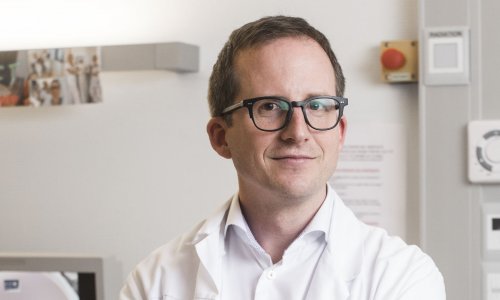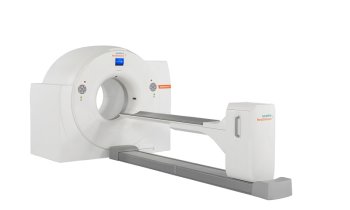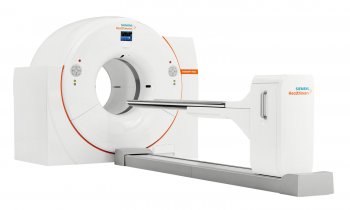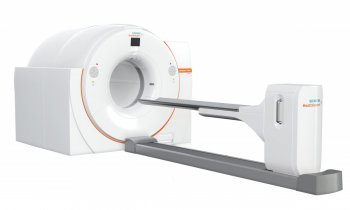Nuclear medicine fuses with radiology in joint session
A special feature of this year’s scientific program at ECR 2010 was a joint session organized by the European Association for Nuclear Medicine with the European Society of Radiology. Two speakers representing the EANM took the podium to review developments in nuclear medicine and to challenge colleagues on specific applications.
Wolfgang Weber, MD, from the University of Freiburg spoke on the topic, “New probes to increase specificity and sensitivity of PET/CT in oncology.“
Demonstrated improvement in the specificity and sensitvity of PET begins, he said, with a well defined molecular target, depends upon identifying a specific ligand that can then be optimised to create an imaging probe.
Once established, he said, “you can use this probe for several applications.”
“The first application may be for the selection of patients who might benefit from a labelled treatment where there is an expression of the molecular target”, explained Dr. Weber.
“We can also use this technique for therapy monitoring with a potential to block receptors, which becomes very useful information in helping to develop a new drug,” he said.
“Finally, and I think this will become more and more important, PET-CT with nucelar medicine can be used not only for imaging purposes, but for therapy as well,” he said.
“ Increasingly new forms of treatment are being used in Europe,” he concluded, adding, “studies show using peptide receptors with a combined approach of molecular imaging and molecular therapy using PET for targeting radionuclide therapy is a promising and safe approach in palliative therapy of patients with neuroendocrine tumors.”
Thomas Hany, MD, with the Department of Nuclear Medicine at the University Hospital Zurich spoke on the topic, “The added value of contrast-enhanced PET/CT.”
After presenting a series of cases covering approaches now available including dose parameters, types of contrasts and across a series of conditions with issues affecting imaging for lymphoma, pancreatic and and breast cancers. He challenged where contrast-enhanced PET/CT is really needed and who in the medical chain of care is requesting such imaging.
He then showed cases where unenhanced CT was equally capable of revealing the targeted disease states and offered that at his own center they no longer are using the advanced techniques for specific forms of cancer in routine practice.
“What about lymph nodes, for example,” he challenged. “Everyone says that PET/CT is the best way to go for imaging lymph nodes, yet this is not the case. Ultrasound plus fine needle aspiration remains the gold standard.”
For other tumor types, specifically colorectal cancers, ENT cancers and pancreatic cancers contrast-enhanced PET/CT is deterlined to be the modality of choice to deliver the answers needed by a surgeon.
“The issue is radiation, and here is where we need to be sure we are setting the exposure as low as possible,” said Dr. Hany.
“For example, at our center we are no longer going to do the full body approach where we scan from the head to the groin,” he said. “We only examine in the specific region of interest, and more specifically for the head and neck for ENT cancers, and in the groin for pancreatic and colorectal cancers, where there is a demonstrated necessity.”
“I do not believe there is a case any longer for using contrast-enhanced PET/CT for lymphomas, for the breast or for full body examination for melenomas,” he concluded.
The podium was then turned over to two speakers presenting topics on behalf of ESR.
Claire Smith, MD, from Mater Misericordiae University Hospital in Dublin, presented a sobering case reviewing the “Causes and imaging features of false positives/ false negatives on PET/CT in oncologic imaging.”
The uptake of fluoro-deoxy-glucose (FDG), the the most commonly used PET tracer for clinical molecular imaging in oncology is not reserved for tumors alone, being absorbed throughout the body.
Brown fat is classic study for radiologists and is seldom confused with malignancy, she said.
More challenging examples of false positives include flare phenomenon caused by FDG that hve led led to a recommendation for an unecessary cessation of therapy, as well as effects from other therapies, including dental work, that a patient may undergo separate from any oncological therapy.
Dr. Smith equally presented false-negatives, cases where PET/CT fails to identify malignant conditions, such as with carcinoid tumors that are PET-negative.
PET/CT presents a continuing challenge for interpreting radiologists, most especially in cases considered routine, she concluded, to distinguish cancer-specific indications for the range of benign conditions that can take up FDG and lead to mis-diagnosis overstating of disease and unnecessary biopsies.
The final speaker, Heiko Schöder, MD, from the Memorial Sloan-Kettering Cancer Center in New York offered a leading-edge view of an array of new tracers under investigation that replace FDG and more precisely target specific types of tumors.
Yet where FDG is easily created in a hospital setting, some of these advanced tracers require a complex support, he said, adding that for the promising new tracer choline, “you will want to have a cyclotron handy as the half-life is just 120 minutes.”
07.03.2010











